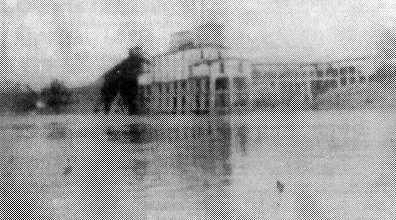
Danville Wharf - Grainery and Steamboat landing.

Dear readers, I just want to tell you what a blessing I got at our church last Sunday. First I want to make a point. I am in no way saying anything against any church. If we are Christians we all love the church we attend. At Chalk Hill there are 15 to 25 on Sundays. We have no programs planned, the Lord leads. We have a precious two-year-old, we let him be a child and we enjoy him. If someone brings in copies of a different song than we are not use to. What if we do mess up? We try it. "We're just God's children and He is there. We have our time to say what's on our mind, share our happiness and sorrow. We are one happy, loving family. And the Lord makes the decision as to how our services go. Again no offense to how any church runs theirs. Just bragging on the way we do our.
Mr. Ira Bell had some interesting facts posted on the Internet about Danville, Tennessee. I wrote Mr. Bell asking him if I could use the this information, and could he send me more. I got a nice reply, with additional information. I mentioned this to a friend in Waverly, Mr. Harold Vickors. Did I ever get a surprise when he asked what I wanted to know. His dad and mother, Leon and Allene Sexton Vickers, lived in Danville and moved when the lake was flooded. He showed me several pictures. Thank you two for a good story.
Danville was founded in 1860. It was a shipping port village on the Tennessee River. The village was located on land owned by Seth Outlaw. The population in 1878 was about 150, and about 40 of these were blacks.
The L&N Railroad crossed the Tennessee Rover at Danville. During the Civil War, Federal troops were sent to guard the bridge and railroad.
A six-mile railroad branch ran from L&M Memphis line at Danville to Stribling area. It was called Danville and LaGrange Railroad. This railroad connected with the iron furnace near Stribling to pull the elevator.
A elevator was built by the L&N Railroad Company about 1915, and its primary purpose was for the transfer of freight between railroad and river and vice-versa. The freight consisted mostly of peanuts, mussel shells, grain, coal, and general merchandise. It had three open floors, so regardless of the height of the river, they could transfer the merchandise. Freight elevators were used to lift and lower the freight between the floors. The elevator near the old coal chute was enterprising business known as "Bootlegger," with his corn squeezing.
Sometime in the early 30s there was a train which came into Danville to do some local switching. After switching they did not have time to get to Stewart for a passenger train and clear the main track for him, since there was no passing track at Danville. Their only alternative was to back down the river lead toward the elevator, where they had over 3/4 mile of track beyond the coal chute.
The conductor advised the locomotive engineer that he was out of some of that good Danville "White Lightning," so he said they had back down the lead a distance of about a mile and he would replenish his supply. He gave the engineer a signal to back up, this starting their journey to the bootlegger's house, where the conductor and flagman hopped off and started getting their supply. One of them looked up and saw that a switch (a machine that switched a train from one track to another) was lined for the incline track that went down the river, instead of being lined for the long tail track, as was the normal position. The train's engine was around a curve from them and they could not signal to the engineer to stop. All they could do was stand by and watch the caboose as it went into the water and as it floated off the wheels and down the river.
Continued next week.
Server space for the TNGenWeb Project is provided through the generosity of US Internet.
The TNGenWeb Project makes no claims or estimates of the validity of the information submitted and reminds you that each new piece of information must be researched and proved, or disproved by the weight of evidence.
You are welcome to copy information found on the Benton County TNGenWeb site for personal use, and share information with other researchers or genealogical organizations, but this information may not be sold or used in a commercial project without expressed permission. All material submitted by individuals for inclusion in this site remains their property.